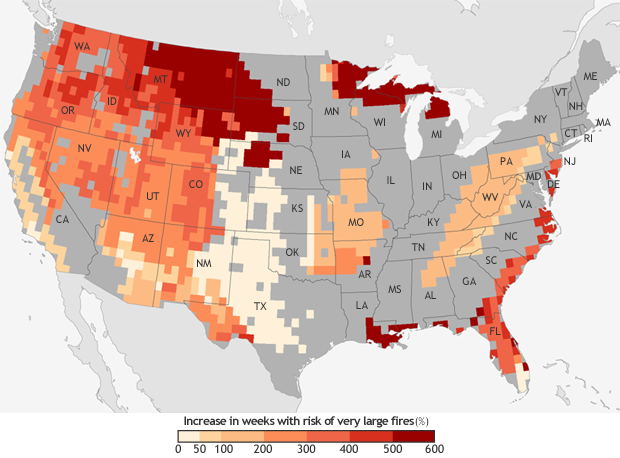One Map Shows the Terrifying Future of Wildfires in the U.S.

By:
There are more than 70 wildfires burning in the Western United States, the National Oceanic and Atmospheric Administration (NOAA) reports, although according to NBC News, that number is even higher, with close to 100 wildfires battled by approximately 30,000 firefighters from across the country. Forecasters say that in the future, wildfires across the U.S. are expected to get worse.
Wildfires around the U.S.
This wildfire season has seen the largest blazes ever in Washington state's history. Earlier this week, Washington Gov. Jay Inslee (D) called the fires, which have burned more than 1,150 square miles, a "statewide slow-motion disaster." The area burned is close to the size of the state of Rhode Island, according to the state Department of Natural Resources.
Fires in Washington state have claimed the lives of three firefighters and burned at least 40 homes, the Associated Press reported. (The Seattle Times has an interactive map of where fires are currently burning in the Western half of the U.S.)
The current drought, which has taken a toll on Western states including California, Nevada, Arizona, and Washington, is creating dry conditions ripe for wildfires. And climate change has only exacerbated the drought, according to a study published in August by the journal Geophysical Research Letters. "Global warming caused by human emissions has most likely intensified the drought in California by 15 to 20 percent," the New York Times reports.
NOAA explains the effects of the current fires:
"The smoke created by these fires exacerbates chronic heart and lung diseases while also degrading visibility and altering snowmelt, precipitation patterns, water quality, and soil properties. In addition to public health impacts, projected trends in extreme fire events have important implications for terrestrial carbon emissions and ecosystems."
The impact of climate change.
More wildfires similar to the ones we are seeing this summer are likely to both impact and be impacted by climate change. While some areas of the U.S. are expected to see more precipitation (and/or more extreme storms) as a result of climate change, other areas are likely to see droughts and heat waves.
"The potential future effects of global climate change include more frequent wildfires, longer periods of drought in some regions and an increase in the number, duration and intensity of tropical storms," NASA explains.
A study funded by NOAA, released earlier this week, details how wildfires will intensify due to climate change.
"Warming due to increasing greenhouse gas emissions will likely increase the potential for ‘very large fires’—the top 10 percent of fires, which account for a majority of burned areas in many regions of the United States," NOAA reports. "Climate change is expected to both intensify fire-friendly weather conditions, as well as lengthen the season during which very large fires tend to spread." In addition, fires release greenhouse gasses into the atmosphere, according to a study published in the journal Forest Ecology and Management.
On Wednesday, NOAA released a map of potential future wildfires. The map shows the "projected increase in the number of “very large fire weeks”—weeks in which conditions are favorable to the occurrence of very large fires—by mid-century (2041-2070) compared to the recent past (1971-2000)," NOAA explains.
 National Oceanic and Atmospheric Administration - climate.gov
National Oceanic and Atmospheric Administration - climate.gov
The areas most at risk for future fires, according to NOAA, include the Great Basin, Northern Rockies, the Sierra Nevada and Klamath Mountains in Northern California, along with forests around the Great Lakes and along the coastline in the south.
The study was conducted by R. Barbero, J.T. from the University of Idaho, N.K. Larkin of the Pacific Wildland Fire Sciences Laboratory, US Forest Service, C. Kolden also from the University of Idaho, and B. Stocks from the Canadian Forest Service. The study compiled the average results of 17 different climate model simulations.
